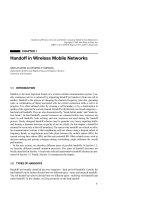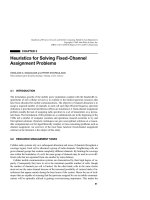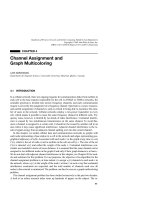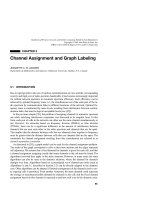Tài liệu Sổ tay của các mạng không dây và điện toán di động P4 doc
Bạn đang xem bản rút gọn của tài liệu. Xem và tải ngay bản đầy đủ của tài liệu tại đây (171.22 KB, 24 trang )
CHAPTER 4
Channel Assignment and
Graph Multicoloring
LATA NARAYANAN
Department of Computer Science, Concordia University, Montreal, Quebec, Canada
4.1 INTRODUCTION
In a cellular network, there are ongoing requests for communication links from mobiles in
each cell to the base stations responsible for the cell. In FDMA or TDMA networks, the
available spectrum is divided into narrow frequency channels, and each communication
request is served by the assignment of a frequency channel. Spectrum is a scarce resource,
and careful assignment of channels to calls is critical to being able to maximize the num-
ber of users in the network. Cellular networks employ a low-power transmitter in every
cell, which makes it possible to reuse the same frequency channel in different cells. Fre-
quency reuse, however, is limited by two kinds of radio interference. Cochannel interfer-
ence is caused by two simultaneous transmissions on the same channel. To avoid this,
once a channel is assigned to a certain call, it should not be reused by another call in an
area where it may cause significant interference. Adjacent channel interference is the re-
sult of signal energy from an adjacent channel spilling over into the current channel.
In this chapter, we model cellular data and communication networks as graphs with
each node representing a base station in a cell in the network and edges representing geo-
graphical adjacency of cells. Associated with each node v in the graph at any time is a set
C(v), which is the set of calls or active mobiles in the cell served by v. The size of the set
C(v) is denoted w(v) and called the weight of the node v. Cochannel interference con-
straints are modeled in terms of reuse distance; it is assumed that the same channel can be
assigned to two different nodes in the graph if and only if their graph distance is at least r.
We do not deal with adjacent channel interference in this chapter; see Chapter 20 for mod-
els and solutions for this problem. For our purposes, the objective of an algorithm for the
channel assignment problem is, at time instant t, to assign w
t
(v) channels to each node v in
the network, where w
t
(v) is the weight of the node v at time t, in such a way that cochannel
interference constraints are respected, and the total number of channels used over all
nodes in the network is minimized. The problem can thus be seen as a graph multicoloring
problem.
The channel assignment problem has been studied extensively in the past two decades.
A look at an online research index turns up hundreds of papers on the subject. The re-
71
Handbook of Wireless Networks and Mobile Computing, Edited by Ivan Stojmenovic´
Copyright © 2002 John Wiley & Sons, Inc.
ISBNs: 0-471-41902-8 (Paper); 0-471-22456-1 (Electronic)
searchers involved include radio and electrical engineers, operations researchers, graph
theorists, and computer scientists of all stripes. In this chapter, we limit ourselves to pa-
pers taking a graph-theoretic approach to the problem and, furthermore, to results that
prove some bounds on the performance of the proposed algorithms. A comprehensive sur-
vey of channel assignment strategies proposed in the engineering literature is given in [26]
and techniques used in operations research can be found in [21]. The relationship to graph
coloring and multicoloring was set out in detail in [13]. We use the competitive analysis
framework to analyze algorithms. Basic definitions are given in Section 4.2; see [3] for
more details on competitive analysis and [2] for graph theory. A large part of our focus
will be on the so-called hexagon graphs (see Figure 4.1). It is well known that these are a
very imperfect approximation of real-life cells; nevertheless, they provide a convenient
idealization that continues to be useful in practice. We will look at different values of the
reuse distance parameter; this amounts to multicoloring powers of hexagon graphs. We
will also look at the results on unit disk graphs. These are the intersection graphs of equal-
sized disks in a plane, where a disk represents a transceiver and its transmission area. Fi-
nally, we will mention a few results on graphs where adjacent cells have some overlapping
areas.
Since the processing of calls and assignment of frequencies is an ongoing process and
present decisions can influence future ones, the channel assignment problem is best mod-
eled in an online fashion. The graph to be multicolored changes over time. These changes
can be modeled as an ordered sequence of graph–call vector pairs {(G, C
t
) : t Ն 0} where
C
t
is the set of new and ongoing calls to be serviced at time t. Clearly, C
t
ʝ C
t+1
may not
be empty. This brings us to an important issue—whether or not a node, when allocating
channels for the next time step, can change the channels it has already assigned to its on-
going local calls on previous steps. An algorithm said to be nonrecoloring if once having
assigned a channel in response to a particular new call, it never changes that assignment
(i.e., recolors the call).
The available technology, however, allows for a limited rearrangement of frequency
channels. It is interesting, therefore, to also consider algorithms that allow recoloring of
calls. In this case, the actual set of calls at any given time step is no longer relevant; just
72
CHANNEL ASSIGNMENT AND GRAPH MULTICOLORING
r
g
b
r
g
b
r
r
r
rr
r
r
r
g
g
g
g
g
g
g
g
g
bb b
b
b
bb
b
Figure 4.1 A hexagon graph with a 3-coloring.
the number of calls at any step suffices to specify the problem. Thus, the problem can now
be modeled as multicoloring a sequence of weighted graphs given by {(G, w
t
): t Ն 0} If
arbitrary recoloring is allowed, it is not difficult to see that the competitive ratio of any al-
gorithm for this online problem is no better than the performance ratio of an algorithm for
the static version of the problem. Essentially, at every time step, run the algorithm for the
static version of the problem, with no concern for how many calls get recolored. Another
motivation for studying the static problem is that the weight of a node can be considered to
represent the expected traffic in the corresponding cell, and an offline solution then gives
a nonuniform, precomputed fixed assignment to be used in the online setting.
It is intuitively clear that recoloring is a very powerful tool, and algorithms that are al-
lowed to recolor are more powerful than those that are not. Upper and lower bounds that
confirm this are reported in the later sections. An interesting challenge would be to devel-
op algorithms that do allow recoloring but only a limited amount. Alternatively, there
could be a cost associated with recoloring, and the algorithm would have to minimize this
cost along with other objectives, or keep the cost below a specified allowable limit. As far
as the author is aware, there has not been significant work in this area.
Another important issue concerns whether the algorithm uses centralized or distributed
control. Some algorithms are inherently centralized: they require knowledge of all nodes
and their current assignments before being able to make an assignment. The strategy in
[35] for reuse distance 2, and the algorithm with competitive ratio 2 for reuse distance 3
given in [9] are centralized strategies. A commonly used strategy precomputes channels to
be assigned to different cells; new calls are assigned channels from these precomputed
sets. This strategy is completely distributed and requires no online communication with
neighbors. There are still other algorithms that can be implemented in a distributed man-
ner, but they require a limited amount of communication with nearby base stations to en-
sure that no conflict occurs. To limit the amount of information about other nodes that
needs to be collected to aid in decision making, the concept of the locality of an algorithm
was introduced in [19]. An algorithm is said to be k-local if the only information available
to a node, apart from its own history, is the current weights of nodes that are within graph
distance k from it. A certain amount of precomputed information independent of the
weight sequence, such as a base coloring of the graph, is also allowable. This model
makes sense for recoloring algorithms; indeed knowing the weight of a neighbor also
gives some knowledge about the decisions the neighbor would make in the current time
step. However, for nonrecoloring algorithms, it would make more sense to allow a k-local
algorithm to also collect information about the current color assignments of nodes in its k-
locality. The distributed algorithms described in this chapter are for the most part synchro-
nous. They proceed in rounds, and a mechanism to synchronize the rounds is assumed. In
[41], however, the algorithm is asynchronous, and is proved to be free of deadlock and
starvation. No bounds are proved on performance, as in the number of channels used in
the average case or worst case.
There are very few lower bounds known for this problem, for either recoloring or non-
recoloring algorithms. Janssen and Kilakos [17] show that for general k-colorable graphs,
the competitive ratio of any 1-local recoloring algorithm is at least k/2 and that of any non-
recoloring algorithm is at least k. These bounds are tight. However, for hexagon graphs or
their powers, tight lower bounds are not known. A straightforward lower bound is the
4.1 INTRODUCTION
73
clique bound [10]: clearly all nodes in any clique in the graph need disjoint sets of chan-
nels. Thus the maximum over all cliques in the graph over the total weight of the clique is
a lower bound for the number of channels needed. Another lower bound is given by odd
cycles [37]: an odd cycle with n nodes needs at least 2W/(n – 1) colors, where W is the
sum of weights of all nodes in the cycle. Most of the known algorithms are deterministic,
and the lower bounds are for deterministic algorithms as well. Randomized algorithms are
given in [27, 48]; the simulation results are promising but no performance bounds are
proved.
A related problem to the channel assignment problem is that of online call control.
Suppose the size of the available spectrum is fixed to be C. Then given a sequence of
weighted graphs, the call control problem is to assign channels to the nodes so as to maxi-
mize the total number of calls admitted. In this case, some calls may actually be rejected,
so the number of channels assigned to a node in a time step may be less than its weight.
An algorithm for channel assignment can generally be converted to one for online call
control. Moreover, the performance bound for channel assignment also translates to a con-
dition for blocking in the case of online control. Suppose an algorithm always produces a
channel assignment with at most kD channels when given a weighted graph, where D is
the clique bound mentioned above. Then it is easy to see that given a spectrum with C
channels, the algorithm will not block unless there is a weighted clique in the graph with
total weight more than C/k. A few recent papers study the call control problem [4, 28, 39]
in both static and online versions. The static version is very similar to the maximum inde-
pendent set problem. For the online version, Caragiannis et al. [4] give a randomized algo-
rithm with competitive ratio 2.934 in hexagon graphs, and also give a lower bound of
1.857 on the competitive ratio of any randomized algorithm for the problem on such
graphs. It is assumed that a single frequency channel is available.
Another related problem is the problem of list coloring [8]. In this problem, every node
of the graph has associated with it a list of colors, which in our case is the list of available
frequency channels. The problem is to find a proper coloring of nodes such that each node
is colored with a color from its list. A number of sequential solutions are known [1, 22,
44]. The relationship to channel assignment was noticed in [11, 31], and a distributed pro-
tocol was given in [11].
The rest of this chapter is organized as follows. Section 4.2 defines the terms we use.
Section 4.3 outlines the basic types of algorithms proposed in the literature, and Section
4.4 summarizes the known lower bound results. Section 4.5 discusses the static version of
the problem, and Section 4.6 the online version. We conclude with a discussion of open
problems in Section 4.7.
4.2 PRELIMINARIES
4.2.1 Graph-Theoretic Preliminaries
Let G = (V, E) denote an interference graph, where the node set V denotes cells or base
stations that require call service, and the edge set E represents geographical proximity of
cells and therefore the possibility of cochannel interference. A weighted graph is a pair
74
CHANNEL ASSIGNMENT AND GRAPH MULTICOLORING
(G, w) where G is an interference graph, w is a weight vector indexed by the nodes of G,
and w(v) represents the number of calls to be served at node v. A static snapshot of the
network at a fixed instant of time is given by a weighted graph (G, w). The goal of an al-
gorithm for the static channel assignment problem, at that instant in time, is to be able to
allocate w(v) Ն 0 distinct channels to each node v ʦ V such that no two adjacent nodes
have channels in common. In graph-theoretic parlance, what is required is a proper multi-
coloring of G with distinct colors representing distinct channels.
Formally, a proper multicoloring of the weighted graph (G, w) where G = (V, E) con-
sists of a set of colors C and a function f that assigns to each v ʦ V a subset f (v) of C such
that
ț ᭙v, | f (v)| = w(v): each node gets w(v) distinct colors
ț ᭙(u, v) ʦ E, f (u) ʝ f (v) =
: two neighboring nodes get disjoint sets of colors.
Thus, a proper multicoloring is equivalent to a valid channel assignment and vice versa.
We use the terms “colors” and “channels” interchangeably in the sequel. Many of the al-
gorithms use a base coloring of the underlying unweighted graph G; it should be clear
from the context when the base color of a node is being referred to, rather than the chan-
nels it is assigned. It is convenient to treat the set of available channels to be a set of nat-
ural numbers. We further assume without loss of generality that any such set can be suit-
ably reordered or partitioned. The span of a channel assignment is the cardinality of the
set C.
For the online channel assignment problem, the set of calls to be served changes with
time. Furthermore, calls cannot always be considered interchangeable and, therefore, the
identities of individual calls may be relevant. We define a call graph to be a pair (G, C),
where G is an interference graph and C is a call vector indexed by the nodes of the graph.
C(v) represents the set of ongoing and new calls requiring service at a node at a particular
instant of time. A call graph has a one-to-one correspondence with a weighted graph,
where w(v) = |C(v)|. We model the changes in the set of calls over time as an ordered se-
quence of call graphs {(G, C
t
) : t Ն 0}, where C
t
represents the set of calls to be serviced
at time t. At time instant t, an online algorithm must arrange to perform an assignment for
the call graph (G, C
t
) before moving on to the call graph (G, C
t+1
) at the next time instant t
+ 1. It must perform this assignment with no knowledge of the later graphs in the se-
quence. As mentioned in the introduction, an algorithm for the online problem may be re-
coloring or nonrecoloring. A recoloring algorithm can change the channels assigned to a
call while the call is in progress, whereas in a nonrecoloring algorithm, a call keeps the
channel it is initially assigned for its entire duration.
If unlimited recoloring is allowed, the online problem becomes equivalent to the static
problem, as an algorithm for the static problem can be used at every time step of the on-
line algorithm. In this case, since the calls can be considered interchangeable, it is the
number of calls at a node that is the relevant parameter. Thus, it is enough to consider the
sequence of weighted graphs {(G, w
t
) : t Ն 0} corresponding to the sequence of call
graphs, and in fact, it suffices to consider each element of this sequence completely inde-
pendently of the others. In practice, though, it is generally desirable to reassign channels
to calls as little as possible.
4.2 PRELIMINARIES
75
We refer to finite induced subgraphs of the infinite triangular lattice as hexagon graphs
(see Figure 4.1). A unit disk graph is the intersection graph of disks of equal diameter in
the plane. They can also be described in terms of distance or proximity models, which
consist of a value d Ն 0 and an embedding of nodes in the plane such that (u, v) is an edge
if and only if the Euclidean distance between u and v in the specified embedding is at
most d. For each fixed pair or real values r, s > 0 a graph G can be drawn in R
d
in an (r, s)-
civilized manner if its nodes can be mapped to points in R
d
so that the length of each edge
is at most r and the distance between any two points is at least s.
An independent (or, stable) set in G is a set VЈ ʕ V such that for any u, v ʦ VЈ, (u, v)
E. Note that a proper multicoloring of G is essentially a covering of G with stable sets;
each stable set of nodes corresponds to a color and a node v appears in exactly w(v) such
sets. The weighted chromatic number of a weighted graph (G, w), denoted
(G, w), is the
smallest number m such that there exists a multicoloring of G of span m, i.e.,
(G, w) is
the optimal number of colors required to properly multicolor G. Let the weight of a maxi-
mal clique in (G, w) be defined as the sum of the weights of the nodes belonging to the
clique; note that when G is a hexagon graph, the only maximal cliques are isolated nodes,
edges, or triangles. The weighted clique number, denoted
(G, w) is the maximum weight
of any maximal clique in the graph. The weighted chromatic number and clique number of
a call graph are defined in an analogous fashion. For integers k Ն 1, we define the k-local-
ity of a node v to be the induced subgraph consisting of those nodes in G whose graph dis-
tance from v is less than or equal to k.
Given G = (V, E), the graph G
r
= (V, EЈ) is defined by EЈ = E ʜ E
2
ʜ ... ʜ E
r–1
. Thus
any pair of nodes at distance i < r in G is connected by an edge in G
r
. The problem of
channel assignment in a weighted graph (G,w) with reuse distance r is thus the same as
multicoloring the graph G
r
. The unweighted clique number of G
r
is the maximum size of
any clique in G
r
, and is denoted
(G
r
). Similarly, the chromatic number of G
r
, the mini-
mum number of colors needed to color G
r
, is denoted by
(G
r
). It is known that when G is
a hexagon graph,
(G
r
) =
(G
r
) (see Section 4.5.3), and an optimal coloring can be com-
puted in polynomial time. We assume that such an optimal coloring of the graph G
r
is
available; thus, every node in G
r
is assigned a color from the set {1, 2, ...,
(G
r
)}. If G is
a hexagon graph, we say that G
2
is a square graph. Figure 4.1 shows a base coloring with
red, blue, and green (r, b, and g) colors for a hexagon graph. It is easy to see that a square
graph can be base colored with seven colors; Figure 4.8 shows such a coloring. We define
N
r
(v) to be all neighbors of v in G
r
, and H
r
(v) to be w(v) + ⌺
uʦN
r
(v)
w(u). Finally, given a
assignment of channels to N
r
(v), RC
r
(v) is defined to be the number of channels assigned
to more than one node in N
r
(v). Thus RC
r
(v) is a measure of the reuse of channels within
N
r
(v).
4.2.2 Performance Measures
An approximation algorithm for the static channel assignment problem is said to have per-
formance ratio r if on any weighted graph (G, w), the algorithm uses at most r(G, w) +
O(1) channels. We use a standard yardstick for measuring the efficacy of online algo-
rithms: that of competitive ratios [25, 3]. Given an online algorithm P that processes a se-
quence of N call graphs (G, C
t
), t = 0, ..., N, let S(P
t
) denote the span of the channel as-
76
CHANNEL ASSIGNMENT AND GRAPH MULTICOLORING
signment (multicoloring) computed by P after step t, i.e., after graph (G, C
t
) has been
processed. Let S
N
(P) = max
t
{S(P
t
)} and
N
(G) = max
t
{
(G, C
t
)}. We say that P is a c-
competitive algorithm if and only if there is a constant b independent of N such that for
any input sequence
S
N
(P) Յ c ·
N
(G) + b
In other words, a c-competitive algorithm uses at most c times as many channels (colors)
overall as the optimal offline algorithm would. We note that all of the algorithms discussed
in this chapter in fact satisfy the stricter requirement
S(P
t
) Յ c ·
(G, C
t
) + b
for all t Ն 0, i.e., they approximate the optimal span within a factor of c at all times while
still processing the input sequence online. All of the lower bounds mentioned in this chap-
ter hold for the above definition of c-competitive (and therefore imply lower bounds on al-
gorithms satisfying the stricter requirement).
4.3 BASIC TYPES OF ALGORITHMS
In this section, we describe the basic types of algorithms developed for channel assign-
ment seen as a graph multicoloring problem.
4.3.1 Fixed Assignment
Fixed assignment (FA) is a very simple, nonrecoloring strategy for channel assignment.
In this strategy, the nodes are partitioned into independent sets, and each such set is as-
signed a separate set of channels [30]. It is easy to see that this works very well when
the traffic is described by a uniform distribution. However, it behaves quite poorly in the
worst case. In particular, the algorithm is k-competitive where k is the chromatic number
of the underlying graph. In [17], it is shown that this is the best possible for arbitrary k-
colorable graphs.
4.3.2 Borrowing Algorithms
To improve the performance of FA, one idea has been to assign nominal sets of channels
as with FA, but allow borrowing of available channels [7, 18, 37, 35]. A simple method is
to have a two-phase algorithm. In the first phase, every node uses as many channels as it
needs from its own nominal set of channels. In the second phase, a node borrows channels
if necessary from its neighbors’ sets of channels. Some mechanism to avoid conflicts
caused by two neighbors trying to borrow the same channel from a mutual neighbor in the
second phase is usually needed. One such mechanism might be to restrict the borrowing in
some way. For example, red nodes can only borrow green channels, green nodes can only
borrow blue channels, and blue nodes can only borrow red channels.
4.3 BASIC TYPES OF ALGORITHMS
77
4.3.3 Hybrid Channel Assignment
Another variation of FA is to assign nominal sets of channels to nodes, but divide these
sets into reserved and channels. The node may use all the channels from its own set, both
reserved and borrowable ones, but may only use the borrowable channels from its neigh-
bors, provided they are not being used by any of the neighbors. Many hybrid strategies
have been studied in the literature [24, 47], but performance bounds are not generally giv-
en. Jordan and Schwabe [23] analyze a simple hybrid channel assignment strategy; the re-
sults for small values of reuse distance are not as good as the borrowing strategies.
4.3.4 Dynamic Channel Assignment
The main characteristic common to all dynamic channel assignment (DCA) schemes is
that all channels are kept in a central pool and are assigned dynamically to radio cells as
new calls arrive in the system. A channel is eligible for use in any cell, provided interfer-
ence constraints are met. DCA strategies vary in the criterion used to select the channel to
be assigned from the set of all eligible channels. They also vary in whether they are cen-
tralized or distributed, and in the synchronization mechanism used in the latter case. A
wide variety of selection criteria to choose the assigned channel can be found in the litera-
ture. For example, in [49], the algorithm tries to maximize the amount of reuse: roughly,
the channel that has been used the most often at distance r but least often at distances r + 1
and r + 2 is used. A number of recently proposed DCA schemes are based on measure-
ment of signal strength from various eligible channels and aim to increase the reusability
of channels (see, for example, [43]). A commonly used strategy [5, 15, 41], is the purely
greedy strategy of using the minimum numbered channel among those eligible. This is the
only DCA strategy for which bounds on the competitive ratio are known.
4.4 LOWER BOUNDS
Graph multicoloring is well known to be NP-hard for arbitrary graphs. Mcdiarmid and
Reed showed that it is also NP-hard to multicolor a hexagon graph with reuse distance 2
[35]; the proof can be adapted for other values of reuse distance as well. It is also known
that multicoloring unit disk graphs is NP-hard; see for example, [12]. Janssen and Kilakos
[17] showed that for a k-colorable graph, any nonrecoloring algorithm has competitive ra-
tio at least k, and any 1-local recoloring algorithm has competitive ratio at least k/2.
As mentioned earlier, the clique bound
(G, w) is always a lower bound on the mini-
mum number of channels needed to multicolor (G, w) [10]. Another lower bound is pro-
vided by odd cycles. Since the maximum size of an independent set in an n-node odd cy-
cle is (n – 1)/2, any color can be assigned to at most (n – 1)/2 nodes. Therefore, the
minimum number of channels needed for an odd cycle with n nodes and reuse distance 2
is at least 2W/(n – 1) colors, where W is the sum of weights of all nodes in the cycle. Thus,
a 9-cycle with equal weight on all nodes requires at least 9
(G, w)/8 channels, and in fact
this number suffices. Since the smallest odd cycle that is a hexagon graph is of length 9,
no algorithm for channel assignment with reuse distance 2 can guarantee using less than
78
CHANNEL ASSIGNMENT AND GRAPH MULTICOLORING
9
(G, w)/8 channels on all weighted hexagon graphs. For higher values of reuse distance,
there are hexagon graphs G such that G
r
is an induced 5-cycle (see Figure 4.2). Therefore
for reuse distance 3 or higher, no algorithm for channel assignment can guarantee using
less than 5
(G, w)/4 channels on all weighted hexagon graphs.
In [19], a lower bound for the competitive ratio of any recoloring algorithm was shown.
The constraint that recoloring can only occur in response to a change in demand within a
node’s immediate neighborhood is added. A recoloring algorithm is said to have recolor-
ing distance k if a node recolors its calls during a time step only if a change of weight has
occurred within its k-locality.
4.4 LOWER BOUNDS
79
Figure 4.2 (a) 5-cycle for reuse distance 3 and (b) 5-cycle for reuse distance 4.
P3
P4
P5
P2
P1
Y axis
X axis
P1 P2
P3
P4
P5
X axis
Y axis
(b)
(a)









